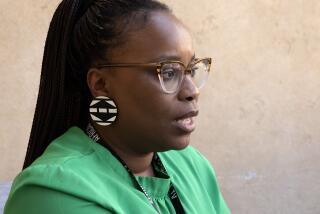Movie-mad diplomat sees film as a tool
CHICAGO — With his crisply tailored suits, confident but courteous manners and distinguished air, Surendra Kumar plays the part of a career diplomat very well. But under it all, Chicago’s consul general from India is a film nut.
Luckily for Kumar, 54, he has been able to forge his passions for diplomacy and cinema into an effective tool to promote a better understanding and appreciation for his country. In each of his postings around Latin America, Asia, Africa and the Middle East, Kumar arranged screenings of Indian films (including art films, historical epics and Hindi musicals) as a form of cross-cultural communication.
Chicago is no exception. During his nearly three years in the city, Kumar has organized retrospectives of Indian film greats Raj Kapoor and Guru Dutt at the Gene Siskel Film Center as well as a “Contemporary Classics of Indian Cinema” series.
In November, Kumar came out with “Legends of Indian Cinema: Pen Portraits,” interviews and essays on his country’s film heroes. In it are profiles of the industry’s top stars from the last 50 years, written with admiration and a definite point of view. It also reveals the author as a lifelong cinephile with an encyclopedic knowledge of film from both the East and West.
We recently sat down for tea with Kumar and talked about his book and the ongoing film retrospectives. Although he spoke freely on Pakistan’s alleged cross-border terrorism into Kashmir and its alleged harboring of Al Qaeda operatives, he declined comment on the touchy subjects of alleged Mafia ties to India’s film industry and the current court case of Bollywood (India’s Bombay-based musical film industry) star Salman Khan, who is accused of running over and killing a bakery worker who was sleeping on a sidewalk.
Question: How useful have you found film as a cultural bridge in your postings abroad?
Answer: I don’t think you can reach people faster than through ... film, whether they are shown on television or in the cinema hall. They are a very important tool of cultural diplomacy.
Q: India was in the headlines this year for the Hindu-Muslim violence in Gujarat, but many of Bollywood’s biggest stars past and present are Muslims. What has that done to reinforce India’s secular values and inter-religious harmony?
A: I have been saying this for a long time: The Indian film industry is the most secular institution in India, not just now, but always. All of our great actors in the past were Muslims, including [actresses] Meena Kumari and Nargis. What happened in the early ‘40s and ‘50s, in Hindu families it was not considered an honorable profession for women. But in India, people are mad about film personalities and they don’t care what religion they are. Shahrukh Khan, Aamir Khan, Salman Khan, they are all Muslim boys. Hindu, Sikh and Muslim girls are all running after them.
What happened in Gujarat was a tragedy. But people have to look at the whole country, 1 billion people. Out of them, Gujarat has about 10 million people, but not everybody [rioted]. In the rest of the country [the violence] didn’t catch fire. It’s like the [Ku Klux Klan] in USA. You have a fringe element that can be anti-black, but not the whole country.
Q: How are Indian film stars different today from 50 years ago?
A: The acting is the same, but some things are changing direction. Music is more racy and fast paced, and the actors have to be more physically attractive. But as I say in my book, Raj Kapoor [an actor who made his name in the ‘50s] was great without having muscles and without bashing anybody. He doesn’t show his biceps, he is not shown jogging, but still you can’t take your eyes off him. [The classic Hindi film] “Teesri Kasam” goes for two hours and 40 minutes, and until the last 10 minutes he doesn’t speak, but you cannot avert your eyes.
Q: So tell me about your main duties here as consul general.
A: Showing films is just a small part of my duties. We organize think tanks and symposia with visiting professors at Midwestern universities to try to influence and get across the point of what India stands for. And perhaps there is much more interest since India’s relations with the U.S. are the best in the last 50 years. The international campaign against terrorism has given a new dimension of cooperation.
Q: Classic Hindi musicals like “Awara” were watched by Mao Tse-tung as well as millions of Soviets, including Nikita Khrushchev and Mikhail Gorbachev, and as you say in your book, during a 1994 visit by actor Mithun Chakraborti to southern Africa, “it was President Chissano of Mozambique who personally asked for his song ‘I Am a Disco Dancer.’ ” Are the new subtitled Hindi DVDs widening the influence of these films even further?
A: Lots of second- and third-generation Indians are now watching, but also elder statesmen of the world. When President Clinton went to India in March 2000, outside of Agra he saw some music men and asked them to play the song “Kaho Na Pyaar Hai” and also “I Am Hero No. 1.” A sitting president asked for these two songs [from Hindi films]. I know these films are bringing the world closer.
*
Monica Eng is a reporter at the Chicago Tribune, a Tribune company.
More to Read
Only good movies
Get the Indie Focus newsletter, Mark Olsen's weekly guide to the world of cinema.
You may occasionally receive promotional content from the Los Angeles Times.










